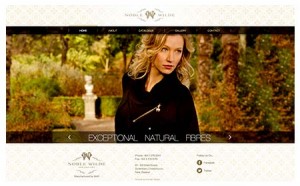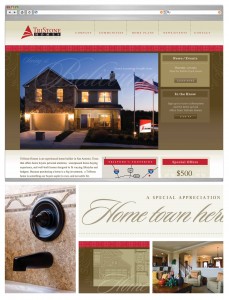The internet is saturated with badly designed cheaply constructed websites. Some of these websites are so bad that it’s easy to assume you can do one on your own that could be a hundred times better. This misconception is amplified with the increasing number of companies promising good web design for an unbeatable price. It’s easy to understand why these web builder services are attractive to businesses looking for an easy answer to website design and development. Let’s take a closer look at web builder services versus professional website development and see which one is right for you.
Build it and They Will Come: The Internet is Your Field of Dreams
 In life, there are no easy answers except maybe when it comes to web design, apparently. At least that’s what the web builder service sites want you to think. Website design is much more complicated than it seems but there are some rather simple rules that accompany it. For instance, if your web site looks professional, potential clients will think you’re professional and then engage your services. A properly constructed website indicates a business that has enough clients and enough income to have invested in a smart site. Imagine how potential clients will perceive you after visiting your poorly made hand-crafted website. Let’s leave arts and crafts up to the kids.
In life, there are no easy answers except maybe when it comes to web design, apparently. At least that’s what the web builder service sites want you to think. Website design is much more complicated than it seems but there are some rather simple rules that accompany it. For instance, if your web site looks professional, potential clients will think you’re professional and then engage your services. A properly constructed website indicates a business that has enough clients and enough income to have invested in a smart site. Imagine how potential clients will perceive you after visiting your poorly made hand-crafted website. Let’s leave arts and crafts up to the kids.
Professional web developers, be my guest and build your own sites to your hearts’ content. IF you’ve got the know-how (and multitudes of time), then by all means, use them. But if you’re not a pro then I feel the best option for you is to invest your money in a solid company that can do a great job building your web site wisely in order to maximise the potential traffic.
It doesn’t matter what your business is. In this day and age, it is essential to have an engaging website that will eventually result in extra local and possible global business. Nowadays, local clientele often perform online searches to find what they’re looking for. It is YOUR website that is going to encourage them to walk into YOUR business. If your future customers chance upon your many competitors and they happen to look more reputable or professional than you, you’re going to lose out. It’s an ever increasing competitive market out there and your website is the portal to potential.
Consider this. If a journalist is looking for an expert in your field to feature in her article or on her blog, they’re going to choose the business whose web site looks professional over someone who looks like they don’t know what they’re doing. Word of mouth is some of the best free advertising available to your business, but…you must build it before they come.
It's simple really: invest wisely in getting professionals to create your website and watch the traffic roll in.
Hocus Pocus
 Web builder services offer seductive promises like the ability to create a professional website in just a few hours. They tout web design as being as easy as choosing a few templates and complimentary colour schemes. There’s no denying that these promises are tantalising to business owners who are already under a lot of pressure with day to day work and perhaps dwindling bank balances. If you look past these guarantees what you’ll find is that they end up delivering websites with clunky editors, cluttered back-ends and virtually no traffic. There is no support available to you once you get your DIY website up and running and often implementing change is difficult. Have a look at their customer feedback sections and you’ll see that these promises aren’t what they seem at all: they’re cheap tricks.
Web builder services offer seductive promises like the ability to create a professional website in just a few hours. They tout web design as being as easy as choosing a few templates and complimentary colour schemes. There’s no denying that these promises are tantalising to business owners who are already under a lot of pressure with day to day work and perhaps dwindling bank balances. If you look past these guarantees what you’ll find is that they end up delivering websites with clunky editors, cluttered back-ends and virtually no traffic. There is no support available to you once you get your DIY website up and running and often implementing change is difficult. Have a look at their customer feedback sections and you’ll see that these promises aren’t what they seem at all: they’re cheap tricks.
People think that they’ll save time and money if they do their own web design because that’s how web builder pages advertise themselves. How hard can it be? With all the available software for creating your own web page, there is clearly a market. However, in the long run, what exactly are you saving? How is it advantageous to avoid spending time and money at the beginning resulting in an ineffective web page? Web development on the cheap might get you started but you’ll have to continue to get it redeveloped in order to compete with your competitors who did it properly from the get-go.
When you choose to have a website created for your business, you’re not just looking for a basic online platform for goods and services. It’s critical that your website services your needs in multiple ways: it has to be able to load quickly, it has to be linked up properly and effectively to various social media and most importantly, it needs to be visible in the major search engines. Not one web builder service guarantees any of these vital aspects. They’re predominantly concerned with saving you money.
Let’s Get Philosophical
The problem is and has always been: money. Most people don’t know how much good web design costs or how much it should cost. The best way to look at it is subjectively. The website design we produce for your business is not only a product, it is a service. Building a high quality website involves a complex level of planning. High attention to detail is imperative during the early development stages and this greatly affects cost. The cost depends on what you want to offer your clients and how much of a presence you want your business to have on the web. At the end of the day, web design is like any other service and what you’re willing to pay defines the quality of the service you receive. Perhaps a better question to be asking yourself is How much is my time worth?
Let me take the art analogy even further: can there really be a price placed on a work of art? All good art is a compromise of expert technique and creativity. To most people, good web design is akin to black magic: websites are intangible entities making it difficult for people to fully understand just how much work and planning goes into creating them properly. The creative process is and isn’t a mystery. Perhaps the raw talent that an individual web designer possesses is a bit mysterious as talent is inherent, but there is a lot of practicality and technicality behind impressive web design.
At Activate Design we have an entire staff of talented artisans who design websites starting, basically, with a clever idea. However, it’s the application of expertise and knowledge that really makes our website design stand out. When choosing a company to help you with web design, you shouldn’t just be looking at creative and technical track records. A good web design company must also push themselves beyond their own creative desires to produce something that includes the client’s vision. The math is easy: your idea plus our expertise equals excellent web design.
Easy Does It
I’ve never trusted the idea of ‘easy’. If web design was that easy to do, wouldn’t there be a higher level of design apparent on the Internet? Problems with hosting, issues with fake domain renewals and sketchy security protocols are not what you think you’re signing up for when you choose to go with web builder services but they are essentially part of the package.
As Kiwis, we are an innovative and hand-on breed. We apply our Number 8 Wire mentality to all that we do and we usually pull it off with aplomb. But when it comes to website development, we’ve got to know when to leave things in the hands of the experts otherwise the expenses could add up. A smart business owner recognises the value of having the right people in place. They don’t waste their valuable time and resources on trying to learn HTML because they are focused on growing their business.
I’ve received a lot of emails and calls from people who ventured down the DIY path only to find themselves going astray without anyone to turn to for advice. It is only once they’re in the middle of their project, at a virtual point of no return, that they realise the whole design process is considerably more challenging than it seems. A good quality website is more than just a logo, colour scheme and content. It’s so easy! Point and click! Web builder sites claim to be “non-technical user friendly” but how will a non-technical website be customer-friendly?
Do the Right Thing
There’s nothing easier than finding the right web team that you can work with closely and build not only an excellent website, but a solid working relationship constructed on the foundations of trust and respect. These teams can serve as your media advisors and can guide you in the right direction. Just because you’re hiring a team of professionals to help you with design doesn’t mean that your input won’t factor into the decisions made. We will work with you every step of the way and everything we develop will be signed off by YOU.
At Activate Design we see effective web design as a collaboration process. We want you to come to us with your amazing, internet-altering, ground breaking dreams. But we want you to let us help make those dreams come true. After all, it’s what we do best.





 Everyone makes mistakes—even web designers. However, some mistakes can be disastrous, such as those that affect traffic. You never want users to click away because the site’s interface is too complicated to navigate. According to
Everyone makes mistakes—even web designers. However, some mistakes can be disastrous, such as those that affect traffic. You never want users to click away because the site’s interface is too complicated to navigate. According to -modified.jpg) Smartphones have evolved to become much more than just our personal communication devices - they are internet browsers, social networking platforms, music players, personal assistants and personal development tracking. They are the link to our online presence, our access to business and personal data, and the way that we both map and navigate through our lives.
Smartphones have evolved to become much more than just our personal communication devices - they are internet browsers, social networking platforms, music players, personal assistants and personal development tracking. They are the link to our online presence, our access to business and personal data, and the way that we both map and navigate through our lives.-modified.jpg)
 A blog is an alternative to a loud and obvious advertising and marketing campaign, seen through the eyes of a discerning online audience.
A blog is an alternative to a loud and obvious advertising and marketing campaign, seen through the eyes of a discerning online audience. YouTube
YouTube Twitter
Twitter Facebook
Facebook Combined with a growing interest in more creative non-fiction style writing and a move to using the webpage almost as an artistic medium, 2014 is about innovation while focusing on a streamlined visual identity that thrives on a minimalistic and unified experience through the use of flat design, easy navigation and focused colour schemes. Developing a site with these top trends in mind will ensure the best possible reception of a site’s content and overall function.
Combined with a growing interest in more creative non-fiction style writing and a move to using the webpage almost as an artistic medium, 2014 is about innovation while focusing on a streamlined visual identity that thrives on a minimalistic and unified experience through the use of flat design, easy navigation and focused colour schemes. Developing a site with these top trends in mind will ensure the best possible reception of a site’s content and overall function.


 WHAT LOCAL PEOPLE ARE LOOKING FOR ON THEIR MOBILE DEVICES
WHAT LOCAL PEOPLE ARE LOOKING FOR ON THEIR MOBILE DEVICES